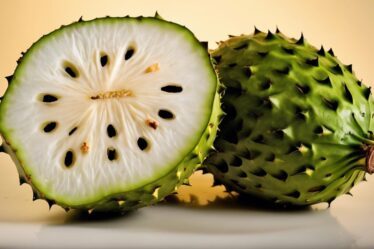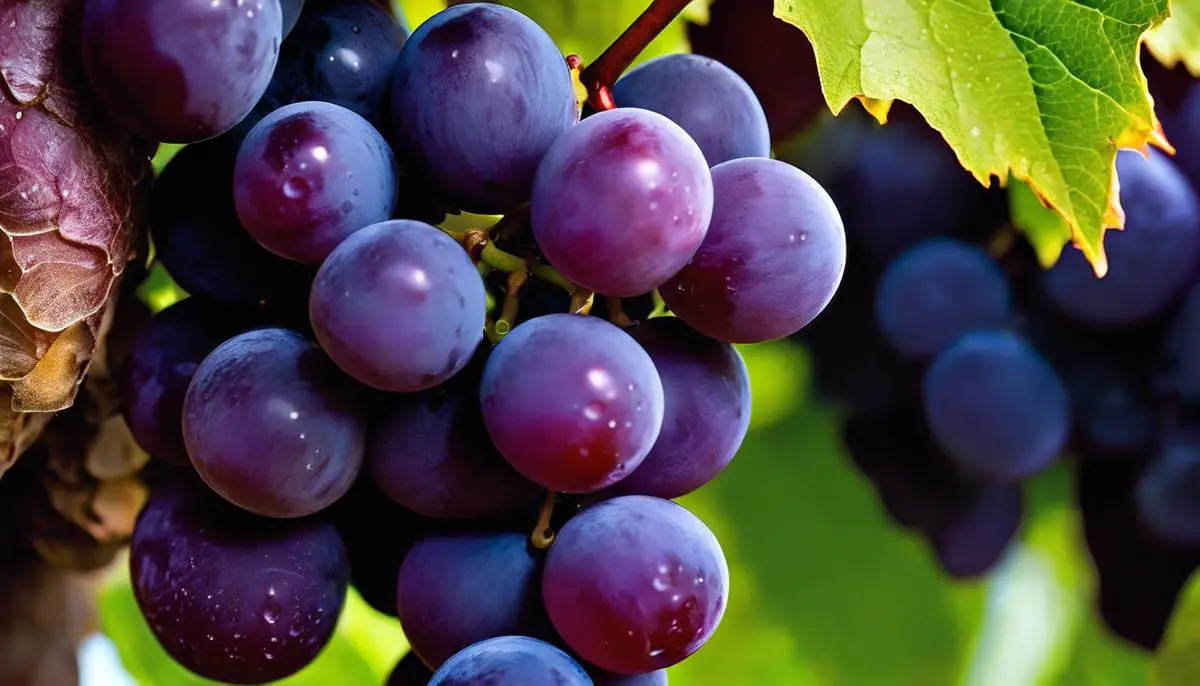
The allure of Champagne Grapes extends far beyond the sparkling effervescence of the world’s most celebrated beverage. These diminutive orbs of sweetness carry with them a legacy steeped in history and luxury, captivating the palates of gourmands and the curiosity of connoisseurs alike. As we peel back the layers of their distinctiveness, we uncover a story of origin and opulence, appearance and aroma, all interwoven to create a tapestry as rich as the wine they inspire. In this exploration of Champagne Grapes, we invite you to immerse yourself in the intricate dance of flavors and finesse that elevate a simple fruit to an emblem of gastronomic elegance. From the sun-kissed vineyards to your very own table, we are set to unravel the enigma behind these celebrated grapes and how they can grace your culinary experiences.
Understanding Champagne Grapes
The Effervescent Enigma: Unveiling the Charm of Champagne Grapes
Have a hankering for something truly special in the fruit aisle? Let your taste buds tango with the tantalizing tease known as Champagne Grapes. No, not the ones you’re thinking of. Forget the bubbles; these diminutive darlings are not the grapes used to make that celebratory sparkling wine we all adore. They’re something much more enchanting.
Champagne Grapes are actually a captivating varietal of Vitis vinifera, aptly named the ‘Black Corinth’ grape or even more alluringly, the ‘Zante Currant’. What sets them apart is their teeny, tiny stature and an undeniably sweet, delectable flavor. When a bunch graces your palm, the grapes are no larger than a pea, a size that’s all part of their charm. You could blink and consider them as nothing but minute adornments, but such oversight would be a disservice to your culinary journey.
Indulge into a cluster, and you’ll understand why these grapes are more than just a beautiful garnish. Each berry bursts with an intense sweetness, and an almost wine-like flavor with notes that hint of floral and earthy undertones. This makes them a high-end favorite for cheese boards, as the perfect accompaniment that won’t overpower the delicate dance of a fine Brie or an assertive Gorgonzola.
But beyond the board, these little gems stretch the imagination for the cooking connoisseur. Experimenting with these in the kitchen opens up a realm of possibility. Picture, if you will, these grapes roasted and spooned over a seared duck breast, or perhaps a handful tossed into a slow-cooking autumnal stew, imparting a complex sweetness to savory dishes that’s rivaled by none.
Pastry aficionados revel in their delicacy, too. Imagine a lemon tart taken to celestial heights with a delicate scatter of these edible rubies, or a tangle of Champagne Grapes caramelized atop a buttery puff pastry, their slight acidity cutting through the richness.
Still, their exclusive nature and short season make them a connoisseur’s pursuit. Typically found only in midsummer to early fall, these grapes come in, make their unforgettable mark, and depart all too quickly, leaving epicureans counting down the days until their return.
And there lies the quintessence of Champagne Grapes – an ephemeral treasure that embodies how food not only entices our senses but marks the seasons, stitches memories, and brings us together in moments both subtle and grand. They’re not just fruits; they’re an experience, a shared luxury that continues to inspire those perpetually passionate about the culinary arts.
So the next time these precious pearls appear at your local market, don’t hesitate to welcome them into your kitchen and onto your plates. Get playful with pairings, innovate in your dishes, or simply enjoy them in their natural, sun-kissed glory. After all, Champagne Grapes are here for a delicious moment, not a long one – make sure that moment is savored to the fullest.
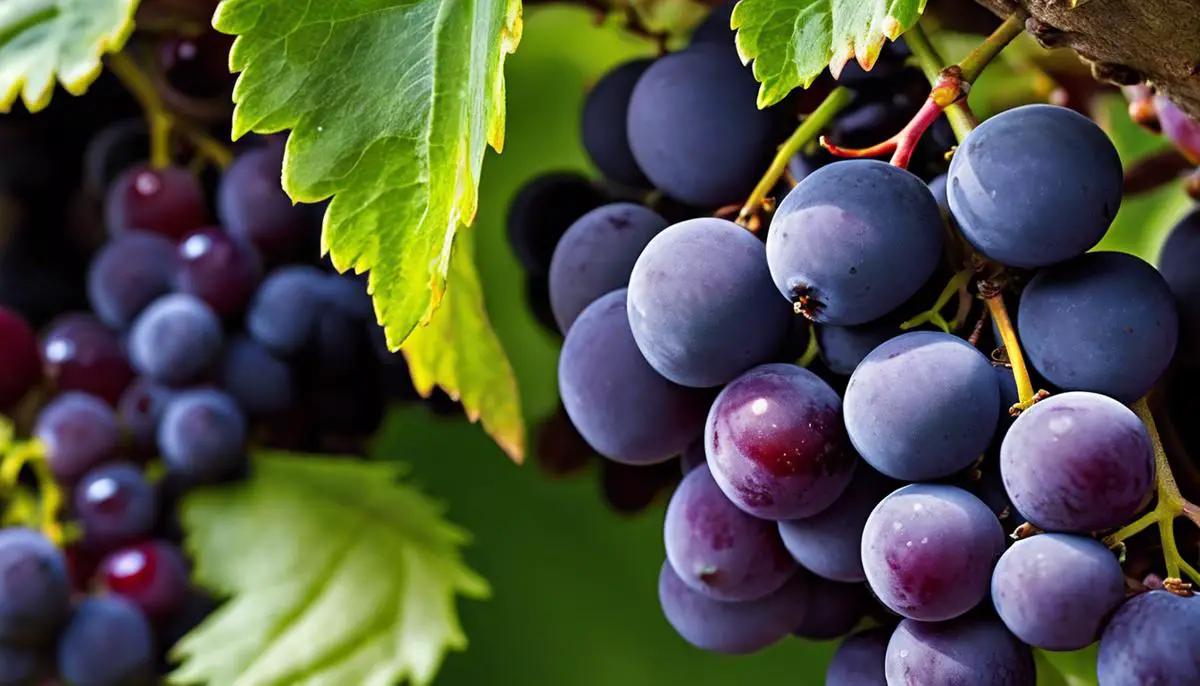
Culinary Uses of Champagne Grapes
Embracing the Exquisite: Champagne Grapes in Culinary Creation
Imagine a tiny burst of sweetness complementing a savory dish with uncanny precision, or lending its subtle essence to an elegant dessert—this is the artistry that Champagne Grapes can bestow upon a culinary experience. These diminutive jewels are not only splendid for their visual appeal but also pack a flavor that can transform the simplest of dishes into an affair to remember.
Beyond the already lauded cheese boards and pastry delights, these little darlings have traversed the culinary landscape into the realm of exotic cuisine. For the intrepid culinary maven, incorporating Champagne Grapes into savory mains can be a revelation. Consider a delicate quail or Cornish hen, its skin crisped to perfection, served alongside a compote of Champagne Grapes, whose acidity balances the richness of the poultry with an almost magical harmony.
Salads, too, dance under the spell of Champagne Grapes. Their tiny size means that each forkful can be laden with other components, never overwhelming but always enhancing. A scatter of these grapes in an arugula salad with slivers of Parmesan and a drizzle of aged balsamic can elevate a side dish to the level of the masterpiece.
As for the world of cocktails and beverages, here is where Champagne Grapes can truly surprise. Frozen and used as ice cubes, they cool without diluting, gradually releasing their flavor in a seductive, slow enchantment. A sprig threaded through a cocktail skewer, submerged in a flute of bubbly, can add that touch of unexpected festivity to an already celebratory drink.
With the fleeting chance to use them, Champagne Grapes invite chefs and food lovers to reflect on the beauty of seasonality. They are a heartening reminder that some things are worth the wait and that their return is a cause for culinary celebration.
So, with the ripening of the vine comes the opportunity to seize these precious globes of delight and use them to weave a spell in every dish they grace. As the seasons pass, and they retreat once more into memory, savor the taste, the moment, and the sheer joy of creating with Champagne Grapes. Until next year, when the vines will once again offer up their treasured fruits, let every bite be a toast to the ephemeral beauty of Champagne Grapes in culinary creation. Raise the glass, and let the feasting commence!
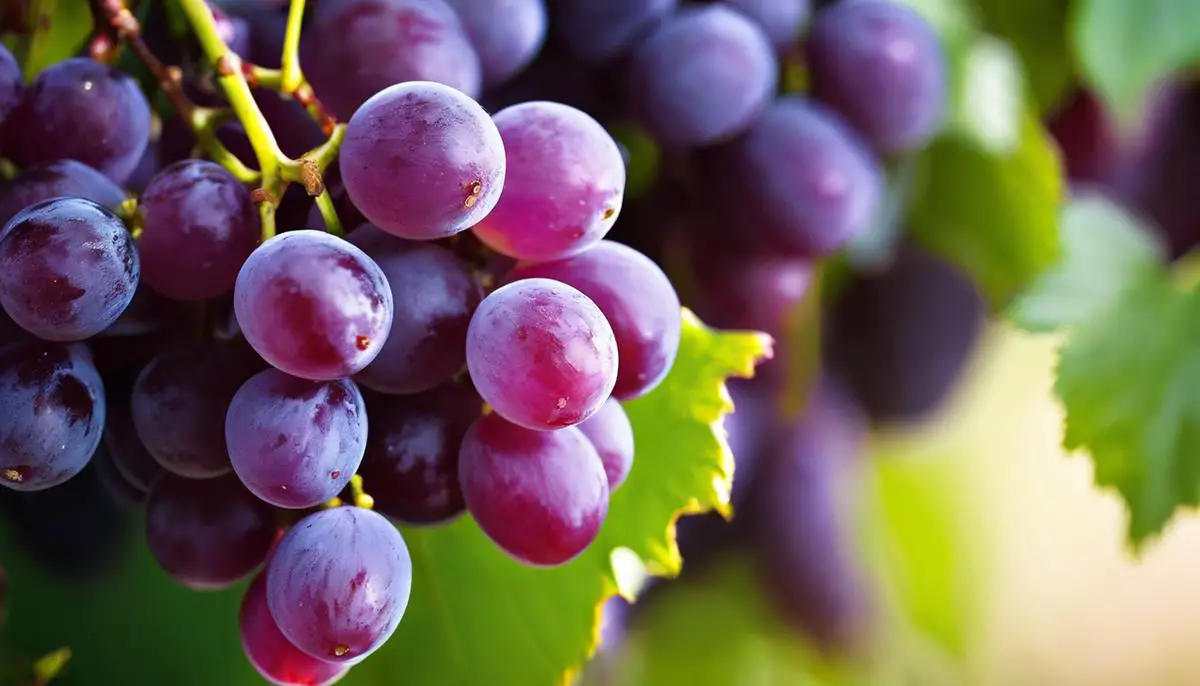
Pairing with Champagne Grapes
Let’s pop into the bubbly world of food and drink — but let’s swap out the Champagne flutes for bunches of delightful Champagne grapes! It’s time to uncork the mysteries of pairing these tiny, yet mighty, bursts of flavor with a symphony of sips and bites that’ll make your taste buds dance.
Now, imagine these tender, sweet morsels tumbling into a garden-fresh salad. Their sun-kissed sweetness brings a perfect harmony to the tang of a sharp vinaigrette and the earthy tones of arugula and walnuts. The juiciness of the grapes offsets the crunch and creates a texture play that’s simply irreplaceable.
But what to sip alongside this creation? Here’s where subtlety and finesse come into play — a glass of crisp, unoaked Chardonnay complements without overshadowing the delicate nature of these jewels. Its light citrus notes dance gracefully with the sweet caress of the grapes, like a waltz that’s reserved only for the peak of summer’s soirees.
Step into the charcuterie realm, where Champagne grapes become the crown jewels on a layout adorned with thinly-sliced prosciutto and creamy burrata. This is where a sparkling Rosé comes in to cut through the richness with its effervescent acidity, creating a palate-cleansing sip after every sumptuous bite. The slight berry notes of the Rosé pair as if they share the same royal lineage as our treasured grapes.
With grill season igniting, those seared, smoky flavors of chicken or pork tenderloin yearn for a companion not just in the marinade — where our sweet little grapes can lend their caramelized sugars — but in the glass, too. Pour a light-bodied Pinot Noir with a hint of earthiness, and watch it gently play up the smoky essence of the meat without overpowering the nuanced notes our seasonal stars bring to the platter.
For those who lean toward the veg-centric side of the culinary spectrum, Champagne grapes provide a delightful burst in roasted vegetable medleys or grain bowls. Drizzle them over roasted brussels sprouts, or scatter them across a wild rice pilaf; wherever they land, a symphony of earthy and sweet notes awaits. To sip? A dry Riesling mirrors the grape’s sweetness while holding its own with racy acidity and mineral undertones, ensuring each forkful is a refreshing voyage of flavors.
And let us not forget the artisanal touch of these grapes in the cocktail scene. A Champagne grape sangria, perhaps, spiked with a touch of elderflower liqueur, embraces the natural sweet-tart profile of our featured fruit. Or envision a spritzer, where the grapes are muddled with fresh basil and topped with sparkling water — an invigorating concoction that’s both elegant and thirst-quenching.
In the end, pairing Champagne grapes with food and drink is a culinary sonnet to the peak of summer’s bounty. Whether these grapes are augmenting the character of a dish or starring in their own right, there’s a pairing that promises to elevate each bite and sip to its fullest potential. And remember, with their fleeting season, each pairing becomes a toast to the present — a celebration of life’s most ephemeral and delicious moments. Cheers to that!

Health Benefits of Champagne Grapes
Let’s dive right in! Champagne grapes, beyond their enchanting nature and palate-pleasing qualities, hold a treasure trove of health benefits that align with a well-rounded diet. These tiny, zesty orbs are not just a feast for the eyes and the palate; they’re packed with an impressive nutritional profile that warrants attention.
When considering Champagne grapes as a healthful addition to your daily intake, remember, antioxidants are the buzzword here. These minuscule morsels are a source of phytonutrients, which combat oxidative stress and inflammation. This incredible attribute isn’t just limited to Champagne grapes but extends to all their vine-ripened cousins. So, while indulging in their luxurious taste, also relish the fact that you’re contributing to your body’s defense system.
Champagne grapes are also friends of a heart-healthy diet. Rich in potassium and low in sodium, they are a smart choice for maintaining a balanced blood pressure. Add to that the dietary fiber they provide, and you have a natural aid for digestive health, which can also contribute to sustaining a healthy weight – talk about a guilt-free treat!
But, let’s get practical. While these grapes do have sugars – they’re a fruit, after all – they’re the kind of natural sugars that come with the benefits of fiber and nutrients. So, incorporating Champagne grapes as part of a balanced snack, or as a touch of natural sweetness to a dish, can be a wise move.
And hydration? With a high water content, these grapes are hydrating heroes, making them a perfect snack to reach for if you’re trying to keep your water intake up but also want something a touch indulgent.
For those managing their sugar intake, Champagne grapes, like any fruit, should be consumed in moderation. They’re naturally sweet, yes, but the fiber helps moderate the absorption of sugars, keeping things in balance for your body.
Now imagine, a late summer picnic, a cool breeze in the air, and a bunch of Champagne grapes at your fingertips – it’s not just nourishment; it’s a sensory symphony paired with the satisfaction of choosing foods that love you back.
In conclusion, Champagne grapes indeed offer more than a mere delight to the senses; they contribute significantly to a health-conscious diet. Whether adorning a posé of cheeses or peppered throughout a mixed green salad that sings of summer, they add that pop of flavor and nutritional goodness. And let’s not get started on a glass of chilled sangria studded with these gems – it’s hydration, antioxidation, and celebration in one sip! So, next time you spot them, remember, Champagne grapes bring more than extravagance to the table – they deliver wellness wrapped in tiny, juicy packages. Keep embracing the moments that allow for culinary exploration with a touch of health-conscious bounty. Cheers to that!

Growing and Harvesting Champagne Grapes
Cultivating the Delightful Champagne Grape: A Farmer’s Harmony with Nature
Tucked away in the vine-laced hills, where dawn kisses the dew-soaked earth, diligent hands toil to cultivate one of nature’s most delicate treasures – the Champagne grape. A task requiring the precision of a seasoned chef and the patience of a fermenting fine wine, growing these grapes is nothing short of an oenological ballet.
The process begins with selecting the perfect terroir. Oh, how these grapes cherish the chalky soils! They bask splendidly under the sun, swaying gently to the rhythm of the northeastern French climate – a concertmaster to their growth. Champagne grapes demand just the right amount of sunshine tempered with cool, breezy evenings, whispering secrets of flavor complexities yet to unfold.
Choosing the right rootstock is akin to picking the perfect spice blend for that unforgettable dish. It sets the foundation for vines to thrive. These grapes won’t settle for anything less than rootstocks that encourage resilience against the nemesis of all vignerons – phylloxera.
Pruning and training the vines are next. One must consider the character of the grapes, akin to a chef pondering the cut of their julienned vegetables. Yet, it’s more than aesthetics; each precise snip determines air flow and sun exposure, catering to the needs of these petite orbs as meticulously as pairing the finest foods.
When the seasons honor the vintners with benevolence, the canopy management ensures the clusters dangle with just enough cover to avert sunburn, yet ample light to sculpt their sugar-acid balance. It’s the vineyard’s dance – a choreography mapped meticulously throughout the growing season.
The harvest – oh, the climactic gathering of flavors! As fates would have it, Champagne grapes demand the most tender and precise of harvests. The time of picking is a decision that teeters on intangible intuition – choosing the moment when sugars and acids find perfect harmony – like capturing the crescendo of a symphony in a single note.
Pest and disease management are a constant vigil. As in any great kitchen, cleanliness and attention to detail prevent the spoiling of the batch. Organic methods are often favored, moving away from harsh chemicals, reflecting respect for both the vine and the eventual imbiber.
Finally, the pressing and fermentation. If the vineyard is a stage, the winery is the artist’s studio. Here, the grapes will transform, gracefully aging into the effervescent nectar we covet. First-press juice is the heart and soul of superior Champagne – where the purest essence of the grape is captured.
In the play of Champagne grape cultivation, every act holds importance. The crescendo of harvest culminates in a glass of luxurious tranquility – a journey from root to effervescence, each step echoing the promise of the vines. This cherished cycle renews yearly, and with each, comes a vintage that reflects the vigneron’s harmonious dance with nature.
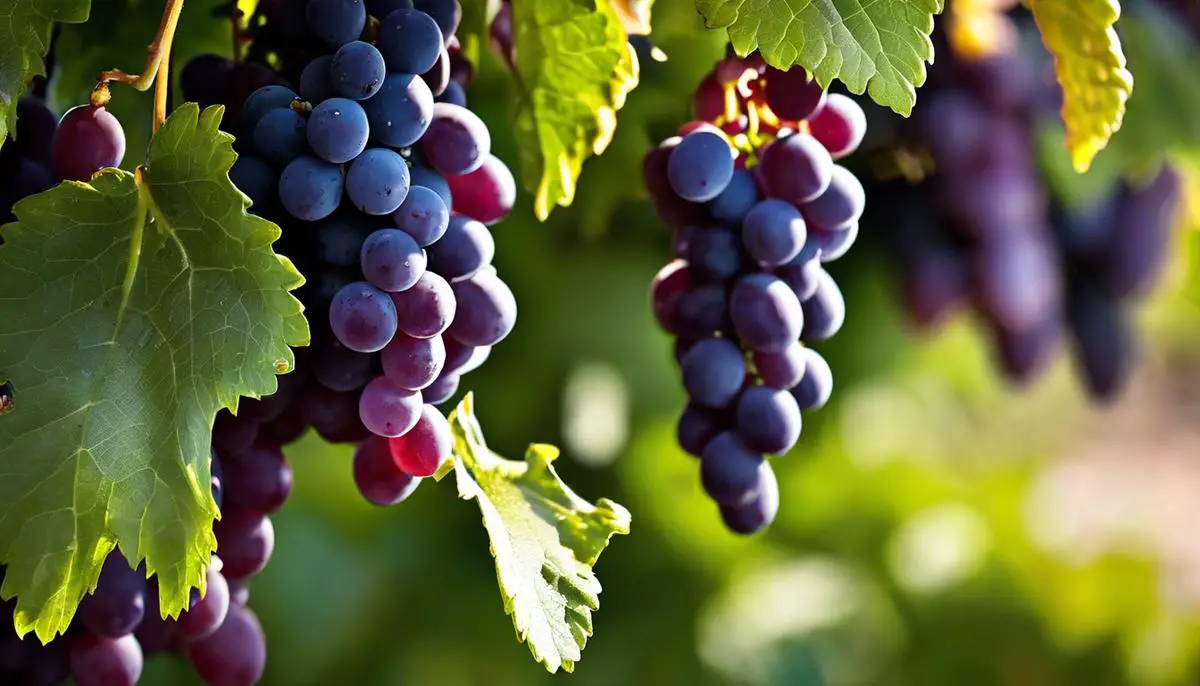
Embarking on the journey through the world of Champagne Grapes has offered a vivid portrait of their splendor, from the sun-drenched vines to the symphony of flavors they contribute to the dining experience. We have savored the stories of their careful cultivation and celebrated the rich tapestry of health and happiness they weave into our diets. As we move forward, carrying with us newfound knowledge and appreciation, let us cultivate a deeper connection to the food we eat and the earth it comes from. May the intricate beauty of Champagne Grapes continue to inspire culinary creativity and remind us of nature’s capacity to produce small wonders that hold a universe of taste within. Here’s to discovering the next delightful surprises they have in store for our senses and our tables.



